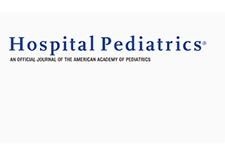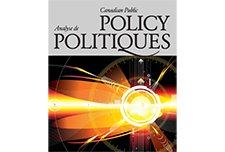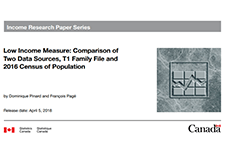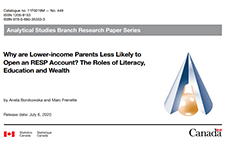Discover financial empowerment resources
Discover financial empowerment resources
The GetYourBenefits! Project began as an attempt to convince physicians that it is important to diagnose and treat poverty. This paper describes how information on accessing benefits has been communicated to physicians, health care providers, and those who work in public...

In Canada and the United States, approximately 1 in 5 children live in poverty, contributing to poor health outcomes. Families with children with chronic illness may experience additional financial stress related to hospitalization. This study aimed to capture experiences of financial needs and...

Food insecurity is a significant public health problem for Indigenous peoples in Canada. A comprehensive literature review is needed to organize the evidence according to the 4 pillars of food security (i.e., availability, access, utilization, and stability) and identify gaps in the published...

The Canada Revenue Agency administers dozens of cash transfer programs that require an annual personal income tax return to establish eligibility. Approximately 10–12 percent of Canadians, however, do not file a return; as a result, they will not receive the benefits for which they are otherwise...

Financial stress is the root cause of many adverse health outcomes among poor and low-income children and their families, yet few clinical interventions have been developed to improve health by directly addressing patient and family finances. Medical-Financial Partnerships (MFPs) are novel...

To mitigate the effects of the coronavirus disease 2019 (COVID-19) pandemic, the federal government has implemented several financial assistance programs, including unprecedented funding to food charities. Using the Canadian Perspectives Survey Series 2, the demographic, employment, and behavioural...

This study presents findings from a measurement of financial literacy using questions assessing basic knowledge of four fundamental concepts in financial decision making: knowledge of interest rates, interest compounding, inflation, and risk diversification. Worldwide, just one in three adults are...

This study looks at the differences in after-tax low income measure (LIM) statistics from two data sources which both use administrative tax data as their principal inputs: the 2016 Census of Population and the T1 Family file (T1FF). It presents a summary of the two data sources and compares...

This study examines the affect that an increase in household income, due to a government transfer unrelated to household characteristics, has on children's long-term outcomes. It is found that increased income increases children's educational...
Parents can save for their children's postsecondary education by opening and contributing to a Registered Education Savings Plan (RESP) account, which provides tax and other financial incentives designed to encourage participation (particularly among lower-income families). While the share of...

This research paper investigates the association between the patterns of duration, timing and sequencing of exposure to low family income during childhood, and symptoms of mental health problems in...

Income volatility is increasing in the United States and presents a growing public health problem. This study examines associations of long-term income volatility with incident cardiovascular disease and all-cause...

A lack of emergency savings renders low-income households vulnerable to material hardships resulting from unexpected expenses or loss of income. Having emergency savings helps these households respond to unexpected events, maintain consumption, and avoid high-cost credit products. Because many...
Research conducted by agencies such as AFOA, Native Women’s Association of Canada, and various other Canadian entities, has identified the need for improved financial literacy education in Indigenous communities, particularly among youth and Elders. Such research reports are often equipped with...

This paper contributes to the literature on the state of household finances in Canada by constructing new indicators using Canadian microdata based on Canadian and international literature. Using data from the Survey of Financial Security (1999, 2005 and 2012), and also the Canadian Financial...
In its 2016 budget, the Government of Ontario committed to conducting a basic income pilot project as part of its preparations for comprehensive reform of its social assistance programs. Taking particular note of “today’s dynamic labour market” and a need to “strengthen the attachment to...
Financial literacy education has long been promoted as key to consumer financial well-being. It is widely embraced as an effective alternative to substantive legal regulation. Yet its effectiveness has never had more than negligible empirical support. This review (1) sets forth the model of...
This report analyzes the Canadian experience with education savings programs, as the US moves towards more comprehensive Children's Savings Account...

This paper discusses how complex is the seemingly simple task of identifying the middle class and determining whether its condition is improving or deteriorating. This is because many variables determine middle-class status, ranging from income and wealth to consumption, with often contradictory...
When the government establishes a social program whose primary purpose is to help provide support to low-income people with disabilities, its success should be measured on how well it achieves that purpose. Unfortunately, there are reasons to seriously question the usefulness of Canada’s...

Recent commentary on the state of the average Canadian’s finances has been sharply divergent, as rosy conclusions clash with much more pessimistic takes. Which is right? From the perspective of income, the news is generally good. But consider assets, and the reality is...
With the growing complexity of financial products and services, there is an increased interest in understanding the psychological components that affect financial decisions. Perceived financial capability is but one component of the broader concept of financial capability that also includes...
The purpose of this article was to detail the process used to establish validity and reliability for a recently developed instrument measuring financial distress/ financial well-being. Knowing that the establishment of validity and reliability of an instrument is an ongoing process, and keeping in...
This article describes development of the InCharge Financial Distress/Financial Well-Being Scale, designed to measure a latent construct representing responses to one’s financial state on a continuum ranging from overwhelming financial distress/lowest level of financial well-being to no financial...
Alcohol overuse and poverty, each associated with premature death, often exist within disadvantaged neighbourhoods. Cheque cashing places (CCPs) may be opportunistically placed in disadvantaged neighbourhoods, where customers abound. This article explores whether neighbourhood density of CCPs and...
